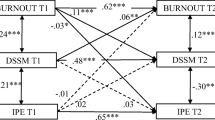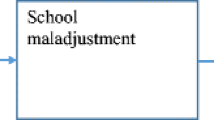Abstract
Recent research shows an increased concern with well-being at school and potential problems associated with students’ use of socio-digital technologies, i.e., the mobile devices, computers, social media, and the Internet. Simultaneously with supporting creative social activities, socio-digital participation may also lead to compulsive and addictive behavioral patterns affecting both general and school-related mental health problems. Using two longitudinal data waves gathered among 1702 (53 % female) early (age 12–14) and 1636 (64 % female) late (age 16–18) Finnish adolescents, we examined cross-lagged paths between excessive internet use, school engagement and burnout, and depressive symptoms. Structural equation modeling revealed reciprocal cross-lagged paths between excessive internet use and school burnout among both adolescent groups: school burnout predicted later excessive internet use and excessive internet use predicted later school burnout. Reciprocal paths between school burnout and depressive symptoms were also found. Girls typically suffered more than boys from depressive symptoms and, in late adolescence, school burnout. Boys, in turn, more typically suffered from excessive internet use. These results show that, among adolescents, excessive internet use can be a cause of school burnout that can later spill over to depressive symptoms.




Similar content being viewed by others
References
Bask, M., & Salmela-Aro, K. (2013). Burned out to drop out: Exploring the relationship between school burnout and school dropout. European Journal of Psychology of Education, 28(2), 511–528. doi:10.1007/s10212-012-0126-5.
Bennett, S., Maton, K., & Kervin, L. (2008). The ‘digital natives’ debate: A critical review of the evidence. British Journal of Educational Technology, 39(5), 775–786.
Bransford, J., Brown, A. N., & Cocking, R. (1999). How people learn: Brain, mind, and school. Washington, DC: National Academy Press.
Carli, V., Durkee, T., Wasserman, D., Hadlaczky, G., Despalins, R., Kramarz, E., & Kaess, M. (2012). The association between pathological internet use and comorbid psychopathology: A systematic review. Psychopathology, 46(1), 1–13.
Carr, N. (2011). The shallows: What the internet is doing to our brains. New York: W. W. Norton & Company.
Carrier, L., Rosen, L., Cheever, N., & Lim, A. (2015). Causes, affects and practicalities of everyday multitasking. Developmental Review, 35, 64–78.
Ceyhan, A. A., & Ceyhan, E. (2008). Loneliness, depression, and computer self-efficacy as predictors of problematic internet use. CyberPsychology & Behavior, 11(6), 699–701. doi:10.1089/cpb.2007.0255.
Ciarrochi, J., Parker, P., Baljinder, S., Marshall, S., Jackson, C., Gloster, A., & Heaven, P. (2016). The development of compulsive internet use and mental health: A four year study of adolescence. Developmental Psychology, 52(2), 272–283.
Dhir, A., Chen, S., & Nieminen, M. (2015). Predicting adolescent Internet addiction: The roles of demographics, technology accessibility, unwillingness to communicate and sought Internet gratifications. Computers in Human Behavior, 51, 24–33.
Eccles, J. S., Midgley, C., Wigfield, A., Buchanan, C. M., Reuman, D., Flanagan, C., & Mac Iver, D. (1993). Development during adolescence: The impact of stage-environment fit on young adolescents’ experiences in schools and in families. American Psychologist, 48(2), 90–101. doi:10.1037/0003-066X.48.2.90.
Gamez, M. (2014). Depressive symptoms and problematic internet use among adolescents: An analysis of the longitudinal relationships from the cognitive-behavioural model. Cyberpsychology, Behaviour and Social Networking, 17(11), 714–719.
Gee, J. P. (2007). What video games have to teach us about learning and literacy (2nd ed.). New York: St. Martin’s Griffin.
Gee, J. P., & Hayes, E. R. (2011). Language and learning in the digital age. London: Routledge.
Haapasalo, I., Välimaa, R., & Kannas, L. (2010). How comprehensive school students perceive their psychosocial school environment. Scandinavian Journal of Educational Research, 54(2), 133–150. doi:10.1080/00313831003637915.
Hakkarainen, K., Hietajärvi, L., Alho, K., Lonka, K., & Salmela-Aro, K. (2015). Socio-digital revolution: Digital natives vs digital immigrants. In J. D. Wright (Ed.), International encyclopedia of the social and behavioral sciences (2nd ed., Vol. 22, pp. 918–923). Amsterdam: Elsevier.
Ito, M., Baumer, S., Bittandi, M., Boud, D., Cody, R., et al. (2010). Hanging out, messing around, and geeking out. Cambridge, MA: MIT Press.
Janosz, M., Archambault, I., Morizot, J., & Pagani, L. S. (2008). School engagement trajectories and their differential predictive relations to dropout. Journal of social Issues, 64(1), 21–40. doi:10.1111/j.1540-4560.2008.00546.x.
Jenkins, H., Clinton, K., Purushotma, R., Robison, A., & Wiegel, M. (2009). Confronting the challenges of participatory culture: Media education for 21st century. Macrthur: MacArthur.
Kaltiala-Heino, R., Lintonen, T., & Rimpelä, A. (2004). Internet addiction? Potentially problematic use of the Internet in a population of 12–18 year-old adolescents. Addiction Research & Theory, 12(1), 89–96.
Kim, J., LaRose, R., & Peng, W. (2009). Loneliness as the cause and the effect of problematic Internet use: The relationship between Internet use and psychological well-being. CyberPsychology & Behavior, 12(4), 451–455. doi:10.1089/cpb.2008.0327.
Ko, C. H., Yen, J. Y., Liu, S. C., Huang, C. F., & Yen, C. F. (2009). The associations between aggressive behaviors and Internet addiction and online activities in adolescents. Journal of Adolescent Health, 44(6), 598–605.
Lam, L. T., & Peng, Z. W. (2010). Effect of pathological use of the internet on adolescent mental health: A prospective study. Archives of Pediatrics and Adolescent Medicine, 164(10), 901–906. doi:10.1001/archpediatrics.2010.159.
Li, S., Hietajärvi, L., Palonen, T., Salmela-Aro, K., & Hakkarainen, K. (in press). Adolescents’ networks: Exploring different patterns of socio-digital participation. Scandinavian Journal of Educational Research. doi: 10.1080/00313831.2015.1120236.
Meerkerk, G. J., Van Den Eijnden, R., Vermulst, A. A., & Garretsen, H. F. L. (2009). The compulsive internet use scale (CIUS): Some psychometric properties. CyberPsychology & Behavior, 12(1), 1–6.
Morrison, C. M., & Gore, H. (2010). The relationship between excessive Internet use and depression: A questionnaire-based study of 1,319 young people and adults. Psychopathology, 43(2), 121–126. doi:10.1159/000277001.
Muthén, L. & Muthén, B. O. (1998–2016). Mplus. User’s guide. Los Angeles, CA: Muthén & Muthén.
OECD. (2015). Students, computers and learning. Paris: OECD.
Palfrey, J., & Gasser, U. (2011). Reclaiming an awkward term: What we might learn from “Digital Natives”. In M. Thomas (Ed.), Deconstructing digital natives (pp. 186–204). London, UK: Routledge.
Park, S., Holloway, S. D., Arendtsz, A., Bempechat, J., & Li, J. (2012). What makes students engaged in learning? A time-use study of within-and between-individual predictors of emotional engagement in low-performing high schools. Journal of Youth and Adolescence, 41(3), 390–401. doi:10.1007/s10964-011-9738-3.
Parliament, European (Ed.). (2015). Innovative schools: Teaching and learning in the digital era—workshop documentation. Brussels: European Parliament.
Prensky, M. (2001). Digital natives, digital immigrants. On the New Horizon, 9(5), 1–6.
Prensky, M. (2012). From digital natives to digital wisdom: Hopeful essays from 21st century learning. Thousand Oaks, CA: Sage.
Primack, B. A., Swanier, B., Georgiopoulos, A. M., Land, S. R., & Fine, M. J. (2009). Association between media use in adolescence and depression in young adulthood: A longitudinal study. Archives of General Psychiatry, 66(2), 181–188. doi:10.1001/archgenpsychiatry.2008.532.
Ryan, R. M., & Deci, E. L. (2000). Self-determination theory and the facilitation of intrinsic motivation, social development, and well-being. American Psychologist, 55(1), 68.
Salmela-Aro, K., Kiuru, N., Leskinen, E., & Nurmi, J.-E. (2009a). School burnout inventory (SBI): Reliability and validity. European Journal of Psychological Assessment, 25(1), 48–57. doi:10.1027/1015-5759.25.1.48.
Salmela-Aro, K., Muotka, J., Hakkarainen, K., Alho, K., & Lonka, K. (in press). School Burnout and Engagement Profiles among Digital Natives in Finland: A person-oriented approach. European Journal of Developmental Psychology.
Salmela-Aro, K., Savolainen, H., & Holopainen, L. (2009b). Depressive symptoms and school burnout during adolescence: Evidence from two cross-lagged longitudinal studies. Journal of Youth and Adolescence, 38(10), 1316–1327. doi:10.1007/s10964-008-9334-.
Salmela-Aro, K., & Tynkkynen, L. (2012). Gendered pathways in school burnout among adolescents. Journal of Adolescence, 35(4), 929–939.
Salmela-Aro, K., & Upadyaya, K. (2012). The schoolwork engagement inventory: Energy, dedication and absorption (EDA). European Journal of Psychological Assessment, 28(1), 60–67. doi:10.1027/1015-5759/a000091.
Salmela-Aro, K., & Upadyaya, K. (2014). School burnout and engagement in the context of demands-resources model. British Journal of Educational Psychology, 84(1), 137–151. doi:10.1111/bjep.12018.
Salokangas, R. K. R., Poutanen, O., & Stengård, E. (1995). Screening for depression in primary care Development and validation of the Depression Scale, a screening instrument for depression. Acta Psychiatrica Scandinavica, 92(1), 10–16. doi:10.1111/j.1600-0447.1995.tb09536.x.
Schneider, B., Krajick, J., Lavonen, J., Salmela-Aro, K., et al. (2016). Investigating optimal learning moments in U.S. and Finnish science classes. Journal of Research in Science Teaching, 53(3), 400–421.
Selfhout, M. H., Branje, S. J., Delsing, M., ter Bogt, T. F., & Meeus, W. H. (2009). Different types of Internet use, depression, and social anxiety: The role of perceived friendship quality. Journal of Adolescence, 32(4), 819–833. doi:10.1016/j.adolescence.2008.10.011.
Skinner, E., Furrer, C., Marchand, G., & Kindermann, T. (2008). Engagement and disaffection in the classroom: Part of a larger motivational dynamic? Journal of Educational Psychology, 100(4), 765–781. doi:10.1037/a0012840.
Thorsteinsson, E. B., & Davey, L. (2014). Adolescents’ compulsive Internet use and depression: A longitudinal study. Open Journal of Depression, 3(1), 13–17.
Tuominen-Soini, H., & Salmela-Aro, K. (2014). Schoolwork engagement and burnout among Finnish high school students and young adults: Profiles, progressions, and educational outcomes. Developmental Psychology, 50(3), 649–662. doi:10.1037/a0033898.
Vallerand, R., Salvy, S.-J., Margeau, G., Elliot, A., Denis, P., Grouzet, F., & Blanhauet, C. (2007). On the role of passion in performance. Journal of Personality, 75(3), 505–534.
van den Eijnden, R. J., Meerkerk, G. J., Vermulst, A. A., Spijkerman, R., & Engels, R. C. (2008). Online communication, compulsive Internet use, and psychosocial well-being among adolescents: A longitudinal study. Developmental Psychology, 44(3), 655–665.
Wang, M. T., & Degol, J. (2014). Staying engaged: Knowledge and research needs in student engagement. Child Development Perspectives, 8(3), 137–143. doi:10.1111/cdep.12073.
Willoughby, T. (2008). A short-term longitudinal study of Internet and computer game use by adolescent boys and girls: Prevalence, frequency of use, and psychosocial predictors. Developmental Psychology, 44(1), 195–204. doi:10.1037/0012-1649.44.1.195.
Acknowledgements
Authors Contributions
K S. A. conceived the Mind-the-Gap study, designed the current study and coordinated and drafted the manuscript. K. U. performed the statistical analyses and contributed to the writing of the manuscript. K. H. conceived the Mind-the-Gap study, and helped to draft the manuscript. K. L. conceived the Mind-the-Gap study, and helped to draft the manuscript. K. A. conceived the Mind-the-Gap study and helped to draft the manuscript. All authors read and approved the final manuscript.
Funding
The study has been supported by the Academy of Finland Grants 263328 Mind-the-Gap Lonka, Hakkarainen, Alho and Salmela-Aro and 273872 LEAD Salmela-Aro.
Author information
Authors and Affiliations
Corresponding author
Ethics declarations
Conflict of interest
The authors report no conflict of interests.
Ethical Approval
The study protocol was approved by the University of Helsinki Ethical Review Board in the Humanities and Social and Behavioral Sciences.
Informed Consent
Participation was voluntary, and informed consent forms were collected from both the students and their parents.
Rights and permissions
About this article
Cite this article
Salmela-Aro, K., Upadyaya, K., Hakkarainen, K. et al. The Dark Side of Internet Use: Two Longitudinal Studies of Excessive Internet Use, Depressive Symptoms, School Burnout and Engagement Among Finnish Early and Late Adolescents. J Youth Adolescence 46, 343–357 (2017). https://doi.org/10.1007/s10964-016-0494-2
Received:
Accepted:
Published:
Issue Date:
DOI: https://doi.org/10.1007/s10964-016-0494-2




